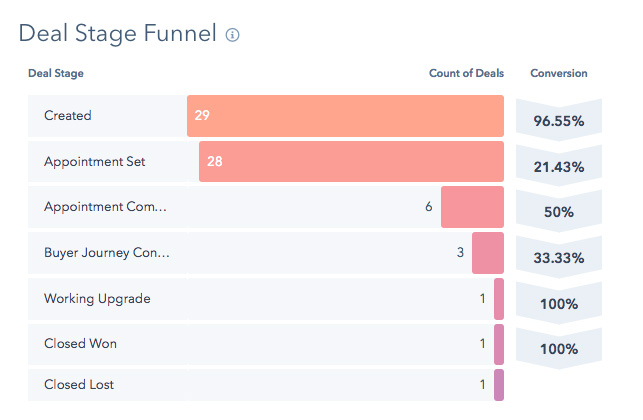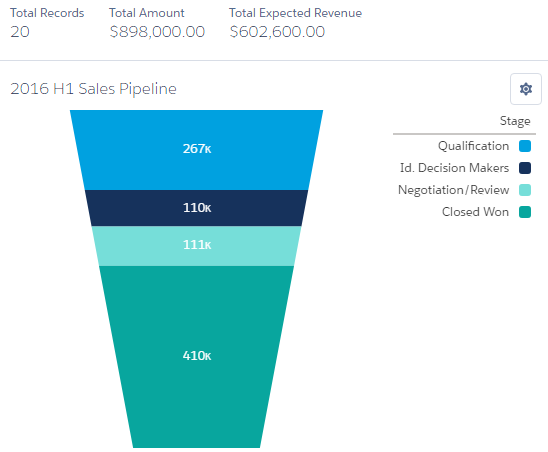A sales funnel visualizes the stages of your sales process, showing the customer buying journey from awareness to purchase. The “funnel” shape reflects how if you add leads to the top of a funnel, the number decreases incrementally until only a small percentage that converts to customers reach the bottom of the funnel. In this article, we discuss what is a sales funnel, its benefits, and the five common stages applicable to most small business sales funnel strategies.
Monitoring the value of the deals in each stage of your sales funnel can help your sales forecasting activities. Use a customer relationship management (CRM) tool like HubSpot that automatically calculates the value of deals in each business funnel stage.
What Are the Benefits of Having a Sales Funnel?
Building a business funnel provides your business with numerous advantages. Some of these benefits include visually organized sales information, improved sales forecasting capabilities, and insights for improving overall sales performance.
Here are the top benefits of using one:
A sales funnel is an effective way to visualize your sales process and manage potential opportunities. You can find out how many leads go from one stage to the next, how long a lead stays in each stage, and how many or what kind of sales pipeline activities are most likely to move them along. To do this, use aggregated views and analysis of current leads, prospects, and customers currently going through the sales process.
Because a sales funnel works by visualizing how prospects go through the sales process and convert to the next stage, it can also be used to predict future revenue. To make a sales forecast, use information like conversion rates from the consideration stage to the purchasing decision stage of the funnel. Then, calculate the percentages of leads you expect to close and multiply them by the total estimated deal value in the funnel.
Calculating a sales forecast is based on the number of prospects in the consideration stage, the deal-closing probability of each prospect, and the estimated deal value of each opportunity. This gives you an estimate of how much sales revenue you expect to generate in a given time period.
The formula is as follows:
Check out our article on sales forecast templates to see various samples that may be useful for your unique forecasting needs.
A business funnel example that includes forecasting capabilities is offered in HubSpot CRM. Users can view the status of each lead or opportunity in the form of a funnel with conversion rates, as well as the total potential deal values in the pipeline, creating a reliable sales forecast.

HubSpot sales deal forecasting with funnel style (Source: HubSpot)
Visualizing leads going down a funnel through stages provides opportunities to improve sales performance at each level. For example, if you discover certain stages are taking longer than others, you can create training for sales reps on specific tactics for moving a lead to the next stage.
You can also use funnel information to allocate additional resources needed to maximize conversion rates at each funnel stage. This could entail technology that improves the speed of a workflow, such as sales automation software or customer relationship management (CRM) software with a lead scoring function.
Monitoring and tracking team and individual sales goals isn’t just about total sales revenue generated. It can also refer to the total conversions and conversion rates of a lead to the next sales stage. Since it is essentially a visual of sales stage conversions, it is an effective way to view progress in relation to the current goals in your sales plan.
You can also use sales funnels to determine how many leads are needed in each stage to hit your sales goals. For example, let’s say your goal is to close four deals by the end of the year, and you know the funnel conversion rates are as follows:
- 25% of leads aware of your business are interested in learning more
- 40% of your interested leads want to receive an offer
- 80% of your leads offered need further consideration
- 50% of your leads in the consideration stage agree to purchase
This means to hit your goal of four deals closed, you’ll need to create awareness for at least 100 leads, of which 25 will be interested in learning more. Of those 25, 10 will accept an offer, and eight will need further consideration. Then, four of those eight considering leads will agree to purchase.
5 Stages of a Sales Funnel
The sales funnel process varies for each business depending on product or service offerings, operations, and tasks required to close a sale. Regardless, funnel stages typically include stages when customers become aware of a business, are interested in what it offers, receive an offer, consider the offer, and make a purchase.
When thinking about the sales funnel process, it’s essential to distinguish it from a sales pipeline. The stages of a sales funnel are the current statuses of prospects, while sales pipeline stages refer to the activities taken to turn a prospect into a customer. The best way to relate the two visuals is by looking at a sales pipeline as the activities needed to get leads into the next stage of the sales funnel.
Here are the five common stages for small businesses:
How to Create a Sales Funnel
To create a sales funnel, visualize your customers’ buying journey through your sales process. In doing so, you need to understand and envision your company’s sales progression in a way that can be broken down into stages.
Each stage should represent a stage of the buying journey, such as brand awareness, lead nurturing, offer, consideration, and decision. This helps you define essential sales pipeline activities needed to move a lead from one stage to the next.
More information about developing its stages can be found in our sales funnel template guide. This article provides a step-by-step process and free templates you can download to create and customize your own.
How to Manage & Optimize Your Sales Funnel Successfully
Sales funnel management is all about tracking sales information. Once you establish the stages, assign each lead to the appropriate stage and then move them to the next level as their customer journey moves forward.
It can be used to calculate the conversion rates of a lead from stage to stage. This tells you exactly how many leads need to be in the funnel to produce your desired number of customers and meet your sales goals. Your funnel also tells a story about how effective your sales tactics are at each stage to identify adjustments to improve sales performance.
Top Tools With Sales Funnel Functionalities
Customer relationship management (CRM) systems are excellent tools for monitoring your funnel since CRMs organize contacts and sales opportunities. The records of each lead (or opportunity) can be viewed and edited to show accurate contact information, deal value, and stage in the sales process. These can then be aggregated and converted into a funnel-style visual.
Bottom Line: What Is a Sales Funnel?
The sales funnel definition can be summed up as a visualization used to manage the sales process by viewing each stage of the funnel as it relates to the customer journey. Your team can use sales funnels to assist in forecasting sales, making adjustments to improve performance, and setting and managing sales goals. Plus, sales CRMs leverage technology to help you track sales information and make it easier to compile data and produce one.

